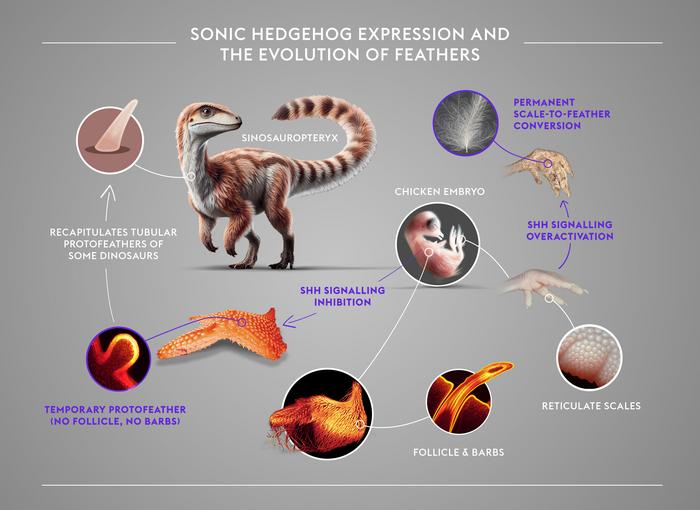The study predominantly focuses on the significance of the Sonic Hedgehog pathway, known for its critical involvement in various developmental processes across species. By specifically investigating its impact on feather development, the researchers employed advanced imaging techniques, such as light sheet fluorescence microscopy. This innovative approach allowed them to observe the intricate patterning of embryonic feathers in real time, leading to a better understanding of how external factors can alter feather morphology. Such insights could illuminate the broader mechanisms underlying developmental biology and evolutionary diversity.
In the experimental design, Cooper and Milinkovitch harnessed the powerful tool of pharmacological inhibition to explore the Shh pathway’s function. By administering sonidegib, an inhibitor targeting the Shh signaling cascade, they were able to disrupt the signaling precisely at embryonic day 9—just before the critical phase of feather-bud outgrowth. This targeted intervention yielded transformative results, notably altering the expression of the Shh gene and leading to the emergence of striped rather than spot-like patterns on the skin surface. This methodological rigor underscores the importance of in vivo experimentation in enhancing our understanding of dynamic biological systems.
The findings revealed that the inhibition of the Shh pathway resulted in profound alterations in feather bud development. Chickens subjected to this treatment exhibited unbranched and non-invaginated feather buds, resembling hypothesized proto-feathers. This observation is particularly significant, as it suggests that the Shh pathway plays a pivotal role in mediating not only feather growth but also the finer details of feather morphology, such as branching patterns and outgrowth dynamics.
The implications of this study extend beyond basic developmental biology to address evolutionary questions surrounding the emergence of feathers. As the authors argue, the ability to transform scales into feather-like structures in a transient manner hints at the evolutionary mechanisms that may have enabled the transition from reptilian ancestors to modern birds. This evolutionary perspective provides a fascinating context for understanding why certain feather characteristics developed in response to environmental pressures while preserving essential functions.
One of the intriguing conclusions to emerge from Cooper and Milinkovitch’s work is that while it is relatively straightforward to alter the development of feet scales, the same cannot be easily said for feathers. This realization challenges researchers to think critically about the evolutionary pressures that shaped feather development specifically, revealing a more complex narrative than previously acknowledged. The study provokes thought about how genetic interactions have evolved and changed over time, fostering the emergence of novel integumentary features such as proto-feathers.
Ultimately, this research not only builds upon existing knowledge in the field but also poses new questions regarding the interplay between genetics and evolutionary biology. The insights garnered from this study could echo throughout the scientific community, influencing future investigations into developmental processes across a broad spectrum of species. Thus, as the authors aptly conclude, understanding the nuances of feather development may hold the key to deciphering the broader narrative of evolutionary change that has shaped life on Earth.
By delving into the intricacies of feather development through the lens of genetic research, Cooper and Milinkovitch have set forth a compelling narrative that brings both depth and clarity to our understanding of evolutionary biology. Their findings serve as a testament to the resilience of living systems, the complexity of genetic interactions, and the endless fascination that the natural world offers to those who seek to explore it further.
Subject of Research: Animals
Article Title: In vivo sonic hedgehog pathway antagonism temporarily results in ancestral proto-featherlike structures in the chicken
News Publication Date: March 20, 2025
Web References: http://dx.doi.org/10.1371/journal.pbio.3003061
References: Cooper RL, Milinkovitch MC (2025) In vivo sonic hedgehog pathway antagonism temporarily results in ancestral proto-featherlike structures in the chicken. PLoS Biol 23(3): e3003061.
Image Credits: Credit: Fabrice Berger & Michel Milinkovitch 2025 (CC-BY 4.0)
Keywords: feather development, Sonic Hedgehog, genetic pathways, avian biology, evolutionary mechanisms, morphological diversity, embryonic development, in vivo research, experimental techniques.
Tags: advanced imaging techniques in biologyavian evolutionary biologydevelopmental processes in birdsembryonic feather patterningevolutionary changes in feather morphologyfeather development in chickensgenetic interactions in feather formationinsights into developmental biologylight sheet fluorescence microscopypharmacological inhibition in researchresilience of avian speciesSonic Hedgehog signaling pathway





